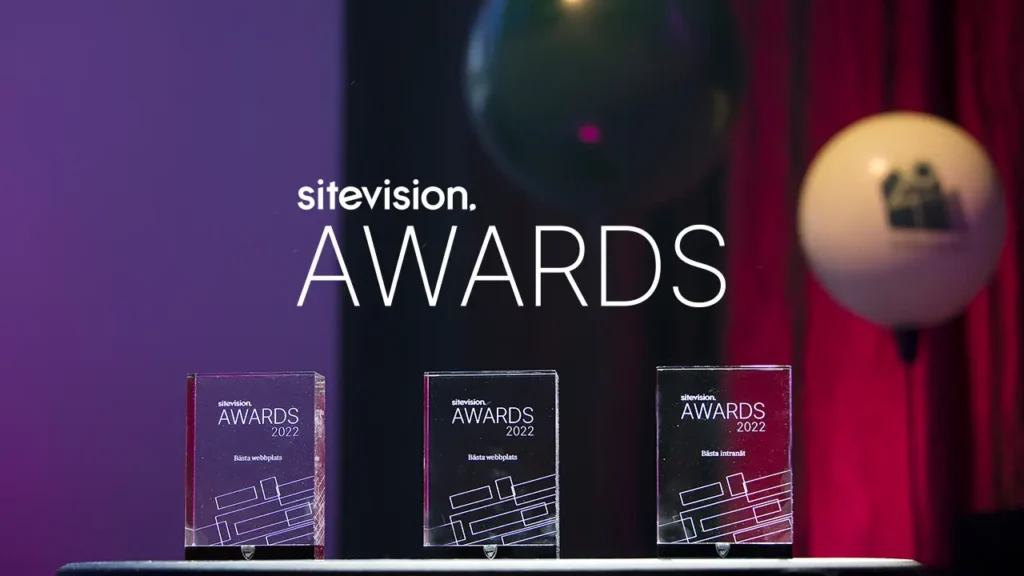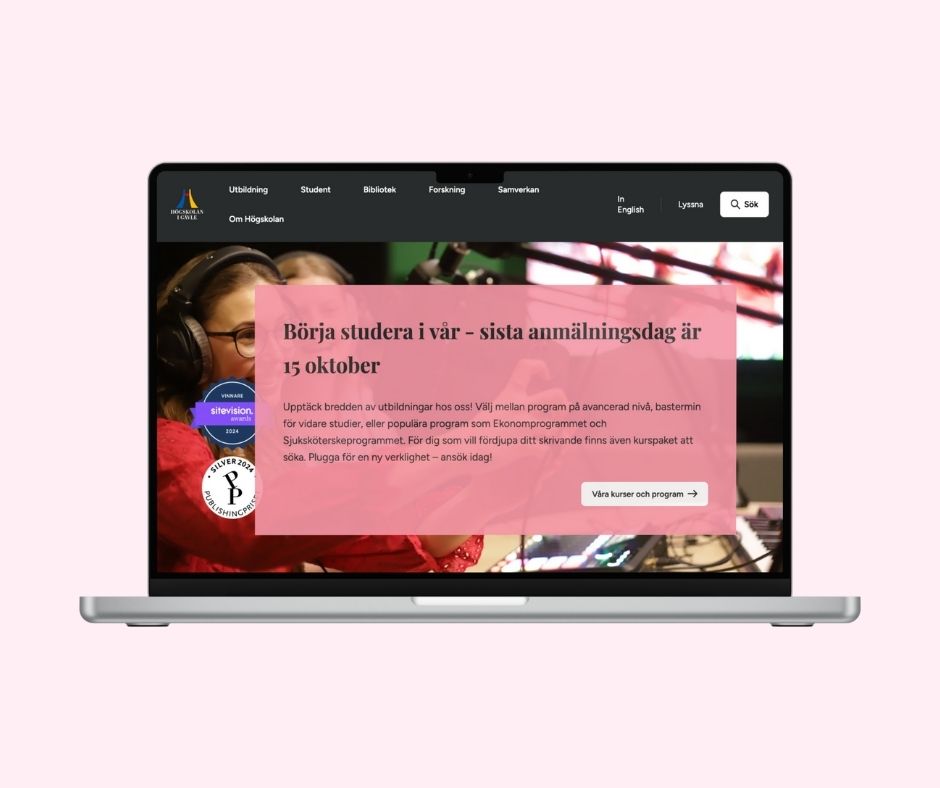How University of Gävle Won the Sitevision Awards – and What Your University Can Learn from the Journey
How University of Gävle Won the Sitevision Awards – and What Your University Can Learn from the Journey
When the University of Gävle (HiG) launched its new website in April 2024, one thing was clear: this was more than a new design. It was a shift in ways of working, governance, and priorities – built on a consistent line from user needs to measurable organizational goals. Shortly after, the proof came: winning the Sitevision Awards (Marketing Website).

Client: Högskolan i Gävle
Industry: Public Service
Solutions Area: Web Development
HiQ acted as end-to-end partner throughout the journey – from impact mapping and concept to development, migration, launch, and management – on Sitevision, a Swedish CMS especially strong for the public sector with built-in support for accessibility, GDPR-secure analytics, and AI features suitable for public organizations.
From “credible but outdated” – to modern, focused, and award-winning
The starting point was clear. The website had basically looked the same since 2015 (with a smaller refresh in 2017). Benchmark studies in 2020–2022 showed it was seen as outdated and dull – but also credible and strong in terms of content. The ambition was therefore to modernize the design without compromising seriousness. At the same time, the website needed to contribute to concrete organizational goals: more first-choice applicants, recruitment for lifelong learning, higher completion rates, better staff recruitment, and stronger collaboration.
Behind the work stood a small, decisive, and capable organization: 14 people in communications/external relations (3 full-time on web/intranet) and 22 local editors – backed by a steering group consisting of academic deans, university director, head of communications, head of IT, and head of educational support.
“We trusted the statistics and prioritized what was actually requested.”
Veronica Liljeroth, Webmaster, Högskolan i Gävle
The groundwork that made everything easier
The core of the project was an impact mapping exercise between October 2022 and April 2023. In a series of workshops (Teams + Miro), leadership, support services, researchers, business, collaboration partners, and current and prospective students took part. The result was nine organizational goals and clear guiding principles that informed every decision.
Some of the key principles:
- Publish where organizational and user needs intersect.
- Give the website a single sender: move content up to HiG as a whole and avoid “islands” per department/faculty.
- Don’t publish what HiG has no authority over (e.g. CSN/Migrationsverket).
- Don’t replace personal contact with too much text.
- All students are HiG’s students – regardless of campus, distance, or study breaks.
The impact mapping became a “contract” between the organization and its users – and a de facto decision-making basis for the steering group. With anchoring from the top and out through the organization, decisions could be made on time and widely accepted.
Design that reduces perceived complexity
HiG deliberately chose a set of design solutions to help users keep focus. One example: when a visitor chooses “Education,” the other top-level menu items disappear. It may sound simple – but the effect is significant: lower cognitive load, fewer distractions, faster paths forward. The layout is airy, with plenty of breathing room for text and navigation.
“We removed what wasn’t needed in the moment – the user should feel the site is less complex than it is.”
Veronica Liljeroth, Webmaster, Högskolan i Gävle


Technology and migration: start right – and start early
Technically, the solution was built on Sitevision. The platform was chosen for its strength in the public sector (accessibility, GDPR-secure analytics, AI support) and future-proofing with integrations and continuously added functionality.
Migration began as soon as the first page template was ready – with a slim migration group that scaled up near launch. A special technical track was the shift of the education database (to Ladok), carried out first on the old site but designed with the new site in mind. The same developers worked across both tracks, and early access to the development environment with test data gave speed and confidence.
Governance that kept the course
Two project managers – one focused on communications and the other on technology – ensured both perspective and pace.
It required honesty and courage in collaboration, but the payoff was clear: less friction between editorial, design, and development, and shorter paths to decisions.
The steering group was engaged from day one. They received materials well before meetings and could decide on the spot. Internally, the project communicated the same vision again and again – a deliberate way to reduce expectation gaps and create calm.
“Transparency and courage. That’s our summary of the project.”
Stina Lilja, Communications Strategist, Högskolan i Gävle
Results – and organizational effects
Shortly after launch, HiG won the Sitevision Awards. A quick survey showed the new site was seen as more modern and self-instructive, while keeping its credibility and strong content. A broader evaluation is planned.
Positive ripple effects also emerged:
- A new image bank with HiG’s own students and staff boosted authenticity (and contributed to the award win).
- Employer branding became a joint effort between HR and communications.
- Accessible documents: a systematic approach to phasing out inaccessible files.
Perhaps most importantly: the way of working lives on – with editorial policy, governance, and a culture where you measure first and opine later.
Why Sitevision and HiQ?
Sitevision provided a solid foundation: a Swedish CMS tailored for the public sector with built-in accessibility checks, GDPR-secure analytics, and AI features suitable for public organizations. The platform makes it easier to meet both today’s requirements and tomorrow’s opportunities (integrations, data infrastructure, new user flows).
HiQ took end-to-end responsibility: impact mapping → concept/UX/UI → development/integrations → migration → launch/management – in iterations, not waterfall. An important detail was to prioritize templates where the most content existed, so editors could start producing early.
Lessons for other universities
- Start with impact. Spend the time to understand user needs and translate them into organizational goals – it saves time later.
- Set governance early. A clear steering group with mandate ensures decisions on time.
- Design for focus. Remove noise; reduce perceived complexity.
- Iterate and migrate early. Build the first template, start filling, improve in loops.
- Measure before opinions. Let data counterbalance “gut feelings.”
- Communicate. Repeat. Anchor. Same vision – over and over again.
- Celebrate wins. It builds pride and stamina in the organization.
“It’s okay not to be ‘finished.’ A website should live – stick to the plan, measure, adjust when motivated.”
Veronica Liljeroth, Webmaster, Högskolan i Gävle
Want to achieve the same results?
If you’re facing a new web solution – or a major redesign – and want your website to drive real organizational goals (student recruitment, completion, staff recruitment, collaboration, and knowledge), we’re ready:
- Sitevision as a platform for the public sector: secure, modern, and flexible.
- HiQ as partner for an end-to-end setup that takes you from impact to management – with a way of working already proven at other universities.
We can show you what a compressed impact mapping looks like, how to prioritize templates to get started quickly, and how to build policy and governance that lasts beyond launch. We can deliver a decision basis in 2–3 weeks – and give you a clear roadmap toward a website that truly delivers on your goals.

Get in touch!
Get in touch!
Choose your nearest office, looking forward to hear from you!



































